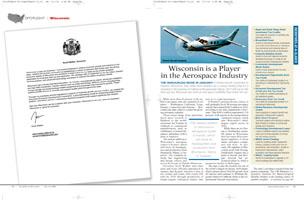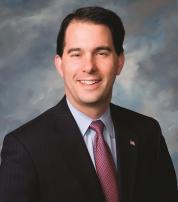
 The announced move in January of Kestrel Aircraft Corporation to Superior, Wisconsin, may strike some skeptics as a curious landing strip for a company in the business of making small passenger planes. Don’t bail out on this story just yet. Wisconsin has more air and space credibility than meets the eye.
The announced move in January of Kestrel Aircraft Corporation to Superior, Wisconsin, may strike some skeptics as a curious landing strip for a company in the business of making small passenger planes. Don’t bail out on this story just yet. Wisconsin has more air and space credibility than meets the eye.
While more than 60 percent of the nation’s aerospace jobs are clustered in six states — Washington, California, Texas, Kansas, Connecticut and Arizona — Wisconsin can stake claim to a small but growing aerospace industry.
Those assets range from university-based space research in Madison to the world-renowned Air Venture in Oshkosh to commercial manufacturers such as Gulfstream, a General Dynamics subsidiary with a plant in Appleton.
The newest addition to Wisconsin’s aerospace cluster is Kestrel, which will move its headquarters and production from Brunswick, Maine, to Superior. The company already has engineering and design offices just across the border in Duluth, Minnesota.
Governor Scott Walker and other state and local officials announced in January that Kestrel, lured by a mix of tax credits and loans, will create 600 jobs by 2016 through production of single-engine turboprop planes that seat six to eight passengers.
If Kestrel’s projections are correct, it will gradually boost Wisconsin aerospace exports that totaled $245.6 million in 2010, according to the state Department of Revenue. That $245.6 million represented 13.8 percent of all exports in the transportation equipment category, which was Wisconsin’s third-largest export sector in 2010.
While there are no Boeing or Bombardier assembly plants in Wisconsin, there are many Wisconsin-based suppliers of those major aerospace companies and more. In fact, some 140 suppliers in Wisconsin work with Boeing. DeltaHawk Engines has a plant in Racine and Morgan Aircraft has announced plans to build a production facility in Sheboygan.
The state is also the location for one of the world’s largest air shows, AirVenture, which attracts about 500,000 people from 60 nations each summer to Wittman Regional Airport in Oshkosh, home to the Experimental Aircraft Association.
The state’s aerospace research base has global credentials. The UW-Madison Cooperative Institute for Meteorological Satellite Studies is the leading source of satellite weather data in the world. The National Oceanic and Atmospheric Administration recently renewed a $60 million contract with the institute.
The UW-Madison is also home to the IceCube Project. Completed in late 2010 at the South Pole, IceCube is the world’s largest neutrino observatory. It was built at the cost of $271 million over 10 years to find extremely high-energy neutrinos — tiny subatomic particles — originating from supernova explosions, gamma-ray bursts and black holes. Scientists believe it will greatly expand knowledge of astrophysics and “dark matter.”
Researchers at UW-Stout have worked on the design and manufacture of functional clothing that has aerospace applications; researchers at UW-Oshkosh have developed a propellant for rocket fuels to increase the speed and efficiency of the fuel’s burn; researchers at UW-Platteville and Oshkosh have developed nano-materials that can help with conductivity and weight issues; and researchers at UW-Milwaukee are engaged in work around composites, sensors, gravitational-wave physics and more.
As it prepares to land in Superior, Kestrel Aircraft Corporation need not feel like Charles Lindbergh on the first successful trans-Atlantic flight in 1927. The company is not flying solo in a state that knows its way around the air and space industry.
 Resource Alignment Key in Business Assistance
Resource Alignment Key in Business Assistance
When Governor Scott Walker announced that Kestrel Aircraft Corporation will establish its manufacturing and headquarters in Superior, Wisconsin, creating up to 600 new jobs, he did so with state and local economic development agencies at his side.
Two state agencies, the Wisconsin Economic Development Corporation (WEDC) and the Wisconsin Housing and Economic Development Authority, partnered with local officials to bring Kestrel’s expansion to Superior. Tax credits and loans were provided by the Wisconsin Economic Development Corporation and Wisconsin Housing Economic Development Authority. Douglas County purchased land for the project and the City of Superior provided a loan to make this relocation happen.
This is just one example of the coordinated effort by the WEDC to align resources within regions and industry sectors to support business and job growth.
The WEDC, which replaced the Wisconsin Department of Commerce in July 2011 to spearhead economic development activities in the state, is building an “extended enterprise” approach to business development in Wisconsin.
For example, in the defense sector, WEDC partners with the Wisconsin Manufacturing Extension Partnership (WEMP) to carry out its Supply Chain Advantage program. The Supply Chain Advantage is a national initiative to enhance the performance of small and midsize suppliers to large Original Equipment Manufacturers (OEM) and military contractors. WMEP works closely with OEMs, suppliers, military contractors and officials with the Defense Logistics Agency of the U.S. Department of Defense to develop and deploy uniform strategies to reduce costs and improve efficiency.
MEP Supply Chain Advantage initially will deliver improvement services to more than 70 suppliers from four major OEM supply chains, with services provided by the national network of MEP centers. The major OEMs include Oshkosh Truck Corporation, Marinette Marine, Rockwell Automation and DRS.
Taking a Targeted Approach
WEDC is also taking an innovative, market-pull approach to target industry growth in the state to accelerate the growth of more industry-led consortia in Wisconsin. WEDC’s targeted industry approach delivers customized solutions to accelerate business consortia that exhibits strong industry leadership, has a defined plan for growth and has realistic potential for strong and long-term economic impact.
For example, WEDC supports the trucking consortia’s efforts in Wisconsin to increase the number of truck drivers and diesel mechanics by coordinating WEDC, Department of Workforce Development and technical college solutions.
This new targeted-industry investment strategy by WEDC has a number of advantages. First, it is not government picking winners or losers but a market-led strategy that accelerates already promising opportunities. Second, it does not apply a one-size fits all solution but provides an approach tailored to the consortia needs. Third, it maximizes the impact of taxpayer dollars by co-investing in solutions that are likely to yield the best results. Information on WEDC initiatives is available at www.wedc.org.

